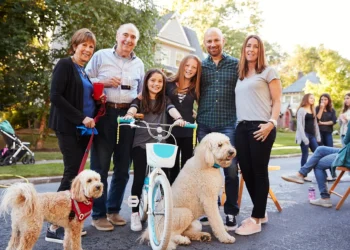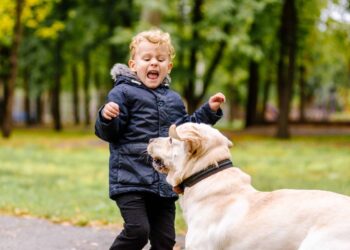Reactive behavior in dogs is a common yet often misunderstood challenge for many pet owners. Characterized by excessive barking, lunging, or snapping in response to specific stimuli, reactivity can strain the bond between a dog and its owner. While this issue is prevalent across various environments, it becomes particularly pronounced in bustling urban cities like Los Angeles.
The city’s constant noise, crowd, and abundance of stimuli can aggravate a dog’s reactive tendencies, making it crucial for owners to understand and address these behaviors effectively. This article aims to explore eight practical ways to manage and train reactive dogs, focusing on techniques that are especially relevant in busy urban landscapes.
Understanding Reactivity in Dogs
Reactivity in dogs is often a manifestation of fear, anxiety, or excitement rather than outright aggression. It’s important to distinguish between a reactive dog and one that’s aggressive, as the underlying causes and appropriate responses differ significantly. Reactive dogs typically exhibit behaviors like barking, growling, or lunging in response to specific triggers, such as other animals, strangers, or loud noises. These responses are usually disproportionate to the actual threat posed by the trigger.
In cities like Los Angeles, the dense population and constant activity can be overwhelming for dogs, contributing to heightened reactivity. To effectively overcome this challenge, it is often wise to seek professional help.
For instance, finding programs for dog training in Los Angeles can be invaluable for local pet owners. Experienced trainers in such programs offer tailored strategies and support, which are essential in creating an environment conducive to the well-being of a reactive dog. These professionals not only address the dog’s immediate reactive behaviors but also work with the owner to establish a long-term management plan.
Identifying Triggers
Identifying what specifically triggers a dog’s reactive behavior is essential for managing and eventually reducing it. Common triggers include other dogs, strangers, loud sounds, or sudden movements. However, each dog is unique, and their triggers can be as varied as their personalities.
Observing a dog’s behavior closely in different situations is key to pinpointing these triggers. Owners might notice, for example, that their dog becomes particularly reactive when encountering cyclists or hearing sirens. Keeping a log of these reactions can help in identifying patterns and understanding the dog’s specific challenges. Once the triggers are known, they can be addressed more effectively through targeted training and desensitization strategies.
Creating a Safe and Calm Environment
Creating a safe environment is essential for the well-being of a reactive dog. In the home, this may involve setting up a quiet space away from windows or busy areas where the dog can retreat when feeling overwhelmed.
This sanctuary should be a secure place that the dog associates with relaxation and safety. Using calming aids like soothing music, pheromone diffusers, or comfortable bedding can also help create a peaceful atmosphere. Adding items with familiar scents and providing gentle, tactile comfort objects like soft toys can further enhance this space, making it a true haven for your dog.
Consistent Routine and Training
A consistent routine is reassuring for reactive dogs, providing a sense of security and predictability. Regular feeding times, walks, and training sessions can help reduce anxiety and improve behavior. Incorporating basic obedience training into the daily routine can also be beneficial. Techniques, like sit, stay, and come are not just commands but tools to redirect a dog’s focus away from triggers.
Training should be positive and reward-based, emphasizing reinforcement over punishment. This approach nurtures trust and understanding, encouraging the dog to learn in a stress-free environment. Rewards can include treats, praise, or playtime tailored to what motivates the dog.
Using a variety of rewards keeps training engaging and enjoyable, helping to build a stronger bond between the dog and owner. Consistent, gentle guidance and patience are key to ensuring the training experience is both effective and rewarding for the dog.
Socialization and Controlled Exposure
Careful socialization is key for reactive dogs. It involves gradually exposing them to various situations, people, and other animals in a controlled manner. This process should be slow and steady, allowing the dog to become accustomed to different stimuli without becoming overwhelmed.
Controlled exposure can involve structured playdates with other dogs, visits to different environments, or attending training classes designed for reactive dogs. In cities, where dogs are often exposed to a wide range of stimuli, finding quiet, less crowded areas for initial exposures can be beneficial.
Exercise and Mental Stimulation
Physical exercise and mental stimulation are key in managing a reactive dog’s behavior. Adequate exercise helps in burning off excess energy that might otherwise translate into reactive behavior. Activities like walking, running, or playing fetch can be tailored to suit the dog’s fitness level and temperament.
Mental stimulation is equally important. Interactive toys, puzzle feeders, and training games can keep a dog’s mind engaged and reduce boredom, which can be a factor in reactivity. In urban settings, where extensive off-leash time might not be feasible, these activities can be particularly valuable in keeping a dog mentally and physically occupied.
Patience and Understanding
Dealing with a reactive dog requires a great deal of patience and understanding. It’s essential to recognize that progress can be slow and non-linear. Owners should be prepared for setbacks and understand that managing reactivity is often a long-term commitment. Empathy towards the dog’s experiences and emotions is crucial. Reactive behavior is not a sign of a bad dog but rather a response to certain stimuli that the dog finds overwhelming or threatening.
Staying calm and composed, especially in challenging situations, can reassure the dog. Celebrating small victories and maintaining a positive outlook is also important for both the dog’s and the owner’s well-being.
Wrapping Up
Managing a reactive dog, particularly in an urban setting, requires a multifaceted approach. Understanding the dog’s reactivity, identifying triggers, maintaining a consistent routine, and seeking professional help when necessary are all crucial steps in this journey. Above all, patience and understanding are key. The path to managing reactivity is not always easy, but it is rewarding. With the right strategies and support, reactive dogs can learn to navigate their world more comfortably. The bond between a dog and its owner can grow stronger through this process, building a relationship based on mutual trust and understanding.










